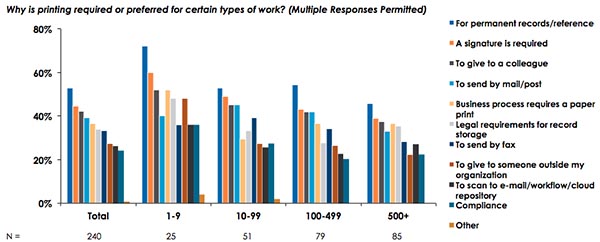- According to Keypoint Intelligence’s research, newly at-home workers in the US were most commonly printing their items at home and sending them out via regular mail.
- 72% of respondents to this same survey report that the COVID-19 crisis led their companies to accelerate the move toward greater digitization of business processes.
- At-home workers who were not printing or scanning files themselves were frequently using a print service provider (e.g., a local office superstore, commercial printer) to accommodate their hardcopy needs.
By Christine Dunne
Introduction
There was a time when a whole lot more of us traveled to and from the office five days a week. Now, however, the ongoing COVID-19 pandemic has many of us working from home much more frequently, even as the economy reopens. The question is, how are people who continue to work from home—at least for the time being—using paper? A recent Keypoint Intelligence study looks at this question from several different angles, and one of which is how they are fulfilling paper-based business processes. For instance, how much are printing at home versus through other means (e.g., via a print service provider), and what they are doing with these prints?
How Job Processes are Fulfilled
According to Keypoint Intelligence’s research, newly at-home workers in the US were most commonly printing their items at home and sending them out via regular mail. Although this might seem surprising in our digital age, it likely reflects the extent to which direct mail is ingrained into our business culture—and perhaps because mail has a way of linking people during this time of social distancing and isolation. This was particularly true for individuals who worked for companies with 250+ employees (63%). These same respondents were also most likely group to be sending their prints by courier service (47%).
Figure 1. Fulfillment of Paper-Based Job Processes

Base: Office Workers newly working at home due to COVID-19
Source: The Future of the Office Survey (US); Keypoint Intelligence 2020
Although the practice of printing at home with plans to file/archive the printout once the office reopens was also fairly common, it should be remembered that many employers remain unsure about when they will reopen their offices. As a result, it is very possible that processes will be redesigned before these employees even have a chance to return the office. To that end, 72% of respondents to this same survey report that the COVID-19 crisis led their companies to accelerate the move toward greater digitization of business processes. As a result, documents like e-mails, spreadsheets, and reports are now more likely to stay digital versus be printed compared to pre-COVID.
Compared to printing at home with plans to file at the office, almost as many newly at-home workers were scanning and e-mailing documents to fulfil hardcopy workflows. In fact, this was actually the top approach for employees in organizations with fewer than 50 people. It is very possible that smaller companies have less money (and space) for practices like mailing and storing paper files. Although they might have previously needed a scanner to scan and e-mail, many employees are increasingly using their smartphones to capture and route digital files—especially if the files are relatively short.
At-home workers who were not printing or scanning files themselves were frequently using a print service provider (e.g., a local office superstore, commercial printer) to accommodate their hardcopy needs. About 45% of total respondents used one of these providers, but this practice became more common as company size increased. This suggests that some processes—especially those performed within larger firms—require capabilities that a typical home printer cannot accommodate (e.g., finishing, photo printing, booklet making).
Some of the findings discussed thus far beg the question: Which processes still require hardcopy files? As mentioned earlier, many companies are accelerating the shift to digitization—driven by the sudden widespread closure of offices and all that they support (e.g., paper files, robust printing technologies, face-to-face interactions with colleagues). Now that these resources are no longer at their fingertips, these workers now require digital tools to do their jobs.
Reasons for Printing
Based on the research that Keypoint Intelligence has conducted in recent years, certain paper-based business processes have persisted more than others. According to a 2018 survey, the most common reasons for continuing to print included the need to store documents permanently or for a certain period of time (often for legal reasons), the requirement for a signature or approval, the desire to give files to a colleague, and the need to send files via the mail. Many of these processes were likely set by the organization some time ago. If the widespread practice of frequently working from home persists, however, it’s very possible that these processes will evolve into more personalized accommodations for specific print jobs.
Figure 2. Reasons for Printing

Base: Office workers
Source: The Future of Office Printing Survey (US); Keypoint Intelligence 2018
The Bottom Line
Keypoint Intelligence’s 2020 Future of the Office study explored remote working and print/document opportunities from a wide variety of angles, including:
- Printing purchases and behaviors associated with remote working
- Attitudes about working from home
- Changes in personal (non-work) printing since the arrival of COVID
- Remote work scanning behaviors
- Other technological purchases and behaviors
In addition to the US version referenced in this article, the 2020 Future of the Officestudy also had a Western European component. The results from this survey can be evaluated in a variety of ways, including by company size, age, type of print device used, and country. For more information, please e-mail Deanna Flanick at [email protected].
Christine Dunne is a Consulting Editor for Keypoint Intelligence’s Office Technology & Services Group. Her responsibilities include responding to client inquiries, conducting market research and analysis, and providing coverage of industry events. Ms. Dunne has written extensively about search engine optimization and pay-per-click advertising.










Discussion
Join the discussion Sign In or Become a Member, doing so is simple and free